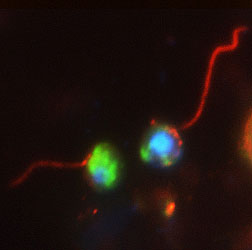Detecting ancient mushrooms Cryptomycota
Photographs of small dots, some of these dots are writhing in a thin tail, providing scientists with a first look of a mysterious, uncovered fungus: Long-lived the oldest, and perhaps the strangest, to this day.
The first view shows that: Although unlike any other known fungus, these fungal cells can develop normally, in essence, they do not have a hard cell wall, but still identify this as a fungus, according to Dr. Tom Richards, working at the Museum of Natural History in London, and Department of Biology, University of Exeter, UK. He calls the new fungus cryptomycota , or " hidden mushroom ." Studying the life stages of this fungus shows: A floating form, parasitic on algae cells, and no sign of the chitin-rich cell membrane, Richards and the study's results colleagues were published in the journal Nature , online issue May 11, 2011.

Two mushroom cells, probably from an ancient lineage, each display a curved, long tail-like tail (red) in a period of rapid transformation in their life cycle.
" People will be very happy ," said Tim James, a mushroom scientist at the University of Michigan in Ann Arbor, USA, who is also studying the ancient cryptomycota mushroom group, or " hidden mushroom ".
By analyzing DNA directly from the environment, Richards and colleagues confirmed that the " hidden mushroom " belongs to a genus of the ancient mushroom industry known as Rozella . Although the researchers found that DNA traces of the " hidden fungus " group were not suitable for any group of fungi discovered in at least a decade, these organisms (so far) still do not developed in the laboratory. This is not an amazing thing, because " hidden mushrooms " are difficult to cultivate.
These studies have shown that a new group of fungi exists, but current studies begin to reveal biological problems. " The question is, is there a period in the life cycle of" hidden mushrooms "without cell walls? ", James said.
When researchers examined DNA sequences from ancient fungal databases " they were discovered more and more (in genetic diversity) over time, including the discovery of types. Mushrooms are known before, "Richards said.
Traces of DNA from the " hidden fungus " group appear in French lakes, US farms and deep-sea sediments, which seem to be the habitat of the " hidden mushroom " group not only in the ocean. Positive, Richards said.
"The big message here is most fungi and the diversity of fungi, most of which are in the group of fungi that have not been collected and have not been cultivated yet ," according to John W. Taylor, who works at Dai. Study in California, Berkeley, USA.
Exeter, a member of the research group Meredith Jones, said: discovering organisms by marking them with fluorescent cards. The procedure shows that fungal cells live on the algae cells. One of the big questions about " hidden fungi " is whether they may have arisen from " some primitive parasitic forms like the ancient Rozella mushroom industry ," according to Rytas Vilgalys of Duke University, USA.
Interesting. Loosening of the definition of fungi, including organisms that do not show signs of chitin-rich cell membranes, can disrupt people's perception of fungi, according to Robert Lücking, who works at the Field Museum. , in Chicago, USA. " I will really try to draw new conclusions, based on the evidence, that this is not a mushroom ," he said. Instead, they can only be close relatives of mushrooms.
- Detecting night glowing mushrooms in Brazil
- Top 10 most rare mushrooms in Vietnam
- Giant mushrooms appear in mass in Hue
- Identify deadly poisonous mushrooms in Vietnam
- 5 types of mushrooms are not only beautiful as fairy but also delicious and incredible
- Eating mushrooms can prevent cancer but not eat meat or fish
- Photos of beautiful mushrooms in nature
- Colorful beauty of mushrooms
- How to identify and prevent poisonous mushrooms
- Bombshell discovered 3 giant mushrooms never seen
- Listening to the people of the net, the Japanese boy was always drinking wild mushrooms growing in the bathroom
- Preventing the ingestion of deadly poisonous mushrooms
 Why do potatoes have eyes?
Why do potatoes have eyes? 'Tragedy' the world's largest carnivorous life: Death becomes ... public toilet
'Tragedy' the world's largest carnivorous life: Death becomes ... public toilet Tomatoes were once considered 'poisonous' for 200 years
Tomatoes were once considered 'poisonous' for 200 years Detecting microscopic parasites on human face
Detecting microscopic parasites on human face